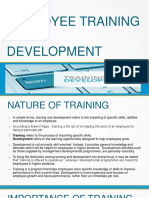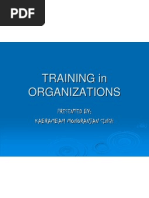Training Methods at BRAC: Lectures
Training Methods at BRAC: Lectures
Uploaded by
gzfvbxfgzbCopyright:
Available Formats
Training Methods at BRAC: Lectures
Training Methods at BRAC: Lectures
Uploaded by
gzfvbxfgzbOriginal Description:
Original Title
Copyright
Available Formats
Share this document
Did you find this document useful?
Is this content inappropriate?
Copyright:
Available Formats
Training Methods at BRAC: Lectures
Training Methods at BRAC: Lectures
Uploaded by
gzfvbxfgzbCopyright:
Available Formats
Training Methods at BRAC
With a purpose to use its skilled and highly skilled workforce effectively. BRAC foster a culture of
organized learning over a given period of time to provide and maximize the change in performance, on
the idea that, Human Resources thrives well with knowledge, skills, and motivation of people, that
grows better with age and experience-that no other resource can attain.
BRAC uses several sorts of methods for employee training which are listed below…
Lectures
Instructor-led training or lecture remains one of the most popular training techniques for trainers. In
BRAC lectures are conducted broadly for two perspectives: Academic & Operation. Lecture on academic
perspective is conceptual and knowledge based training. It develops necessary concepts of particular
learning area. Lecture on operation perspective is work and service related training. It develops the
service quality and improves the skill of the trainee in the field.
Audiovisual instruction
The goal of audio-visual aids is to enhance teacher's ability to present the lesson in simple, effective and
easy to understand for the students. Audiovisual material makes learning more permanent since
students use more than one sense. In BRAC audiovisual instruction is used for orientation of the
organization to new employees. The orientation training is given to employees as soon as they join in BI.
The purpose of this training is to orient the employee to the organization with its culture, values and
tasks; also to link his/her in the organization.
On the job training
On the job training is another way of training employees. In BRAC this type of training is given to
employees who are new to a given job (not necessarily to the organization). The purpose of this kind of
training is to equip the employee with the capabilities required to perform various tasks of his job. For
example, job rotations, internships, coaching and counseling.
Simulations/Action Learning
Action Learning is a process that involves a small group working on real problems, taking action, and
learning as individuals, as a team, and as an organization. In BRAC it also involves off the job training
that requires the workers to undergo training for a specific period away from the work place. These
methods are concerned with both knowledge and skills in doing certain jobs. The workers are free of
tension of work when they are learning.
Roleplaying and Behavioral Modeling
Role Play, or Role Playing, allows a learner to assume the role or tasks of a job by practicing or simulating
real working conditions. In BRAC the objective of role playing is to learn, improve or develop upon the
skills or competencies necessary for a specific position.
Behavior Modeling, a component of Social Learning Theory, is the act of guiding the employees how to
do something by showing them the standard modeled behavior. BRAC uses this process by the idea that
people tend to inevitably learn things they see in a hands-on way.
You might also like
- EXPERIMENT No 8 Muller Layer IllusionDocument11 pagesEXPERIMENT No 8 Muller Layer IllusionArnold Solomon91% (22)
- Reading Comprehension Lesson PlanDocument4 pagesReading Comprehension Lesson Planapi-250565308100% (2)
- H.R Final Exam AASTDocument10 pagesH.R Final Exam AASTA.Rahman SalahNo ratings yet
- Coaching, Mentoring, Job Rotation, in Basket TrainingDocument8 pagesCoaching, Mentoring, Job Rotation, in Basket TrainingdudeprasanthNo ratings yet
- What Is Corporate TrainingDocument38 pagesWhat Is Corporate TrainingAbhijeet Kulshreshtha100% (1)
- Training and Development Mba ProjectDocument81 pagesTraining and Development Mba ProjecteswarNo ratings yet
- Week 8 PHILOSOPHIES OF EDUCATIONDocument8 pagesWeek 8 PHILOSOPHIES OF EDUCATIONMark Uriel Alciso100% (1)
- Purposive CommunicationDocument119 pagesPurposive Communicationaldrin joseph67% (3)
- JCI Local Action GuidesDocument62 pagesJCI Local Action GuidesRosemary Unekwu Ameh100% (2)
- The Sample Concept Map Given)Document4 pagesThe Sample Concept Map Given)Arwen Rae NisperosNo ratings yet
- asssignmentDocument10 pagesasssignmentkamalahmedacharjeeNo ratings yet
- Assignment #1: Types of TrainingDocument4 pagesAssignment #1: Types of TrainingAhmed khushalNo ratings yet
- Module 3 Part 2Document29 pagesModule 3 Part 2soumilidas91221No ratings yet
- Define Traing AssignmentDocument10 pagesDefine Traing Assignmenttanveeralam9538No ratings yet
- Training & Development-1Document30 pagesTraining & Development-1Vishal Kumar RaiNo ratings yet
- Module:3 Training and DevelopmentDocument26 pagesModule:3 Training and Developmentseena15No ratings yet
- Chapter - 03 Theoretical AspectDocument11 pagesChapter - 03 Theoretical AspectTech InfoNo ratings yet
- Upload TraingDocument26 pagesUpload Traingcatchnima19No ratings yet
- Training & Development of HR V2Document24 pagesTraining & Development of HR V2Avijit SenNo ratings yet
- Training in Organizations: Presented By: Kabrambam Monoranjan SinghDocument18 pagesTraining in Organizations: Presented By: Kabrambam Monoranjan SinghMonoranjan KabrambamNo ratings yet
- Training: Presented By:Himanshu Bohra M.B.A. 2 SemDocument22 pagesTraining: Presented By:Himanshu Bohra M.B.A. 2 SemHimanshu BohraNo ratings yet
- Term Paper: Name: Chirag Agarwal Class: BBA - 5A Subject: Human Resource ManagementDocument8 pagesTerm Paper: Name: Chirag Agarwal Class: BBA - 5A Subject: Human Resource ManagementChirag AgarwalNo ratings yet
- M M M MDocument36 pagesM M M MPriyanka Rutul PatelNo ratings yet
- Training and DevelopmentDocument5 pagesTraining and DevelopmentPiche Marie EstacionNo ratings yet
- Training and Development Assiignment.Document11 pagesTraining and Development Assiignment.mubeyinyenuriyeNo ratings yet
- 3.training and DevelopmentDocument29 pages3.training and DevelopmentAkshay Kr TalrejaNo ratings yet
- Training and DevelopmentDocument3 pagesTraining and Developmentgayathri narayanaNo ratings yet
- Coaching: 4 Ans: The Ways Which An Organization Can Implement To Develop Its Employees Are Listed BelowDocument3 pagesCoaching: 4 Ans: The Ways Which An Organization Can Implement To Develop Its Employees Are Listed BelowbikramNo ratings yet
- Bba 202 SM10Document15 pagesBba 202 SM10Vedant SharmaNo ratings yet
- Project On Training & Development in HBLDocument61 pagesProject On Training & Development in HBLPinnam MallikarjunaNo ratings yet
- Training MethodsDocument36 pagesTraining MethodsKhushbu Bavishi67% (3)
- Training and Development 2-1Document9 pagesTraining and Development 2-1nagaiahpanditi51No ratings yet
- Training and DevelopmentDocument44 pagesTraining and DevelopmentNemoNo ratings yet
- AAST HR FinalDocument9 pagesAAST HR Finala7med3abdeenNo ratings yet
- Training and DeveloDocument3 pagesTraining and DeveloshelmercarigabaNo ratings yet
- TRAINING and Development at LuckyoneDocument3 pagesTRAINING and Development at LuckyoneShifa QaziNo ratings yet
- Unit-3 HRMDocument7 pagesUnit-3 HRM3 B 440 YuvankarthikeyanNo ratings yet
- HRM ProjectDocument26 pagesHRM Projectguptasoniya247No ratings yet
- Training and DevelopmentDocument6 pagesTraining and DevelopmentNeo VeloriaNo ratings yet
- Unit 3 HRMDocument60 pagesUnit 3 HRMlakshayNo ratings yet
- Train The Trainer On Job TrainingDocument27 pagesTrain The Trainer On Job TrainingmicotayeNo ratings yet
- BHRM Unit 3Document13 pagesBHRM Unit 3armish24uk11No ratings yet
- Training - Concept & Methods: Rameesha Kalra Monika BhatiaDocument3 pagesTraining - Concept & Methods: Rameesha Kalra Monika BhatiaArti JainNo ratings yet
- Zabihullah - 22149 (Training and Development Assignment)Document16 pagesZabihullah - 22149 (Training and Development Assignment)zabi ullah MohammadiNo ratings yet
- HR 105 ReviewDocument45 pagesHR 105 ReviewJustine CruzNo ratings yet
- Difference Between Training and DevelopmentDocument4 pagesDifference Between Training and DevelopmentSahil Bali100% (3)
- HRM - Chapter-3 - Training & DevelopmentDocument19 pagesHRM - Chapter-3 - Training & Developmentthambi vargheeseNo ratings yet
- Module 7 Learning Training + DevelopmentDocument7 pagesModule 7 Learning Training + Developmentriyanshi.natani398No ratings yet
- Project Report: Various Tools of Training Need IdentificationDocument45 pagesProject Report: Various Tools of Training Need Identificationdinkar108100% (1)
- Training & DevelopmentDocument5 pagesTraining & DevelopmentVigram SenthilkumarNo ratings yet
- Training and Development Notes Unit 2Document16 pagesTraining and Development Notes Unit 2Prabhat ThakurNo ratings yet
- TRAINING AND DEVELOPMENT - JerseyDocument66 pagesTRAINING AND DEVELOPMENT - JerseyVenugopal VutukuruNo ratings yet
- 10 - Training and DevelopmentDocument18 pages10 - Training and DevelopmentRamesh KumarNo ratings yet
- Training and Development in HALDocument58 pagesTraining and Development in HALyoganthmurthy100% (1)
- A Management Thesis Ii ONDocument31 pagesA Management Thesis Ii ONPankaj Mehra100% (1)
- Bcom HonsDocument13 pagesBcom Hons5trrz6p9gzNo ratings yet
- Training & Development and Performance Appraisal: Human Resource Management - M.B.ADocument18 pagesTraining & Development and Performance Appraisal: Human Resource Management - M.B.Anandu1000No ratings yet
- TRAININGDocument10 pagesTRAINING2105729No ratings yet
- Leson 3Document28 pagesLeson 3ladosehrawatNo ratings yet
- Course Title: Strategic Human Resource Development (SHRD) (MGT-503) Chapter04: Training and DevelopmentDocument40 pagesCourse Title: Strategic Human Resource Development (SHRD) (MGT-503) Chapter04: Training and DevelopmentBilal StanikzaiNo ratings yet
- Chapter 7 Lesson 3Document3 pagesChapter 7 Lesson 3Alendy TawayNo ratings yet
- Coach Others in The Job Skills ReportDocument6 pagesCoach Others in The Job Skills ReportThanhNo ratings yet
- 1page MergedDocument14 pages1page MergedsusmithakarikalanNo ratings yet
- bugm8-005tlDocument5 pagesbugm8-005tlshaftududuNo ratings yet
- Enhancing Your Organization's Learning Culture for Business Results: A Practical Guide For ManagersFrom EverandEnhancing Your Organization's Learning Culture for Business Results: A Practical Guide For ManagersNo ratings yet
- The Ultimate Employee Training Guide- Training Today, Leading TomorrowFrom EverandThe Ultimate Employee Training Guide- Training Today, Leading TomorrowNo ratings yet
- Transference: The Transferential/countertransferential RelationshipDocument6 pagesTransference: The Transferential/countertransferential Relationshipkelry78No ratings yet
- Sociology assignment-WPS OfficeDocument6 pagesSociology assignment-WPS OfficeRejitha RNo ratings yet
- The Impact of Language On CommunicationDocument17 pagesThe Impact of Language On CommunicationTime to FunNo ratings yet
- Research SummariesDocument17 pagesResearch Summariesapi-483052208No ratings yet
- Brgy. Lantangan Gigante Sur Carles Iloilo Contact #: 09098797583Document2 pagesBrgy. Lantangan Gigante Sur Carles Iloilo Contact #: 09098797583Rhegine CordovaNo ratings yet
- Academia de San Lorenzo Dema-Ala Inc.: A Detailed Lesson Plan in PoetryDocument8 pagesAcademia de San Lorenzo Dema-Ala Inc.: A Detailed Lesson Plan in PoetryJohn Joshua AlvarezNo ratings yet
- Submitted by - Harleen Kaur Roll No. - 10 B. Arch. 4 SemDocument13 pagesSubmitted by - Harleen Kaur Roll No. - 10 B. Arch. 4 SemHarleen Kaur ChhabraNo ratings yet
- Radical Educational Strategies For New Generations Rev JMTDocument8 pagesRadical Educational Strategies For New Generations Rev JMTAngel Yamil Ortiz Torres100% (1)
- #5 Transition Signals (5) ExplanationDocument2 pages#5 Transition Signals (5) Explanationandy8586100% (1)
- Gaining A Positive Perspective On FeedbackDocument10 pagesGaining A Positive Perspective On FeedbackAnurag SharmaNo ratings yet
- Psychoanalysis 1Document31 pagesPsychoanalysis 1Sam AhnNo ratings yet
- Technostress, Managing Stress, TechnophobiaDocument55 pagesTechnostress, Managing Stress, TechnophobiaDavid WintersNo ratings yet
- CYP1 Intro+DefinitionsDocument3 pagesCYP1 Intro+DefinitionsDiya AggarwalNo ratings yet
- What Is Anger ManagementDocument2 pagesWhat Is Anger ManagementFiffy HazwanyNo ratings yet
- Final Project StructureDocument1 pageFinal Project StructureBrinzila ValentinNo ratings yet
- RESUME SidDocument2 pagesRESUME SidMaynard BaralNo ratings yet
- Role of Impulsiveness in Online Purchase Completion Intentions: An Empirical Study Among Indian CustomersDocument34 pagesRole of Impulsiveness in Online Purchase Completion Intentions: An Empirical Study Among Indian Customersarry widodoNo ratings yet
- Rizqi N A'yuninnisaDocument23 pagesRizqi N A'yuninnisasunu widiantoNo ratings yet
- DeKay, S. - Interpersonal Communication in The WorkplaceDocument5 pagesDeKay, S. - Interpersonal Communication in The Workplacehoney arguellesNo ratings yet
- Assignment 1Document2 pagesAssignment 1Kayla Mae DemaalaNo ratings yet
- Multimodal Early Onset Stimulation (MEOS) in Rehabilitation After Brain InjuryDocument10 pagesMultimodal Early Onset Stimulation (MEOS) in Rehabilitation After Brain InjuryVendiNo ratings yet
- Articleno.2016 (Alat Ukur KD)Document13 pagesArticleno.2016 (Alat Ukur KD)ANETHA FERDERIKA JUNIASINo ratings yet
- Nuestro Reaction PaperDocument4 pagesNuestro Reaction PaperRochelle NuestroNo ratings yet
- Assure Model Instructional PlanDocument3 pagesAssure Model Instructional Planapi-438869347No ratings yet

























































































